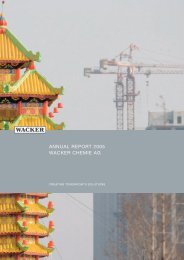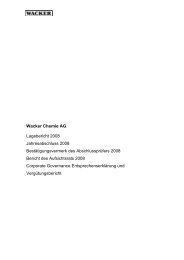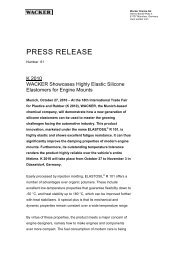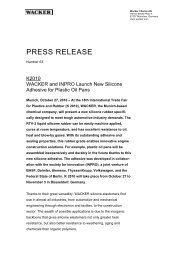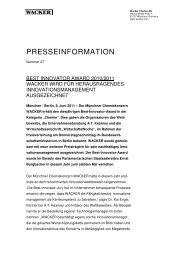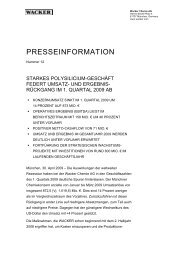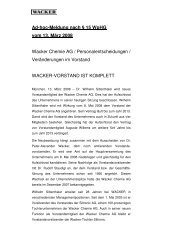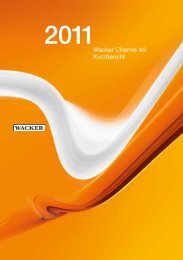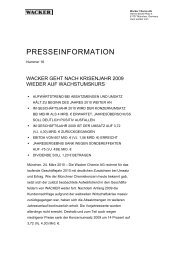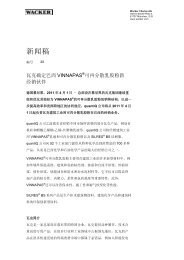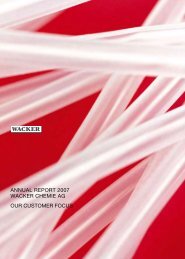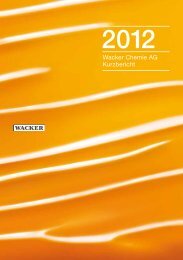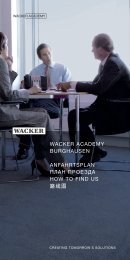Speech Dr. Staudigl (PDF | 61 KB) - Wacker Chemie
Speech Dr. Staudigl (PDF | 61 KB) - Wacker Chemie
Speech Dr. Staudigl (PDF | 61 KB) - Wacker Chemie
Create successful ePaper yourself
Turn your PDF publications into a flip-book with our unique Google optimized e-Paper software.
Not for Release before March 16, 2011, 10:30 a.m.<br />
Annual Press Conference<br />
for 2010<br />
<strong>Speech</strong> by<br />
<strong>Dr</strong>. Rudolf <strong>Staudigl</strong><br />
President & CEO<br />
<strong>Wacker</strong> <strong>Chemie</strong> AG, Munich<br />
March 16, 2011<br />
Munich, Germany<br />
Check against delivery!
Good morning ladies and gentlemen, welcome to our annual press conference.<br />
In 2010, the world economy recovered from the deepest recession since WWII<br />
more rapidly and dynamically than anticipated. The first six months, in particular,<br />
1<br />
saw a rapid upswing. Looking at the full year, GDP grew substantially across every<br />
region – especially in Asia, which reinforced its role as the engine of the global<br />
economy.<br />
WACKER benefited greatly from the momentum on Asian markets. Robust de-<br />
mand for polysilicon and semiconductor wafers boosted our business in the re-<br />
gion. Over the past few years, our chemical divisions have hugely expanded their<br />
production capacities, particularly in China. As a result, we can supply our cus-<br />
tomers there more intensively with locally-manufactured products.<br />
Overall, WACKER generated sales of over 4.7 billion euros in 2010. Up 28 percent<br />
against the previous year. This growth was due to brisk demand for WACKER<br />
products in all our major target industries. Our sales record was mainly fueled by<br />
Siltronic’s robust gains and WACKER SILICONES’ and WACKER<br />
POLYSILICON’s strong performance.<br />
Earnings outpaced sales by a wide margin. EBITDA – earnings before interest,<br />
taxes, depreciation and amortization – amounted to about 1.2 billion euros in<br />
2010. Almost double the prior-year figure. The EBITDA margin rose to over<br />
25 percent, returning to 2008’s high level. Earnings growth was primarily sup-<br />
ported by stronger sales volumes and revenues. High capacity utilization positively<br />
impacted specific production costs.<br />
All in all, WACKER ended 2010 with net income of half a billion euros. Another<br />
record result. Each business division contributed toward this success. Sales and<br />
earnings at all units were considerably better than in 2009.<br />
Our semiconductor business generated especially robust growth. Siltronic bene-<br />
fited from strong electronics demand from industry and consumers. Sales soared<br />
more than 60 percent to over 1 billion euros. Stronger sales volumes made for<br />
Check against delivery!
2<br />
significantly higher capacity-utilization rates. As a result, manufacturing costs were<br />
lower than a year ago. Equally important, prices for some silicon wafer diameters<br />
exceeded prior year’s levels. All these factors helped Siltronic generate an<br />
EBITDA of almost 90 million euros. In 2009, it had posted a loss of over<br />
160 million euros. Naturally, this improvement is not the end of our efforts. We will<br />
continue working on increasing the profitability of our semiconductor business.<br />
Siltronic, though, is definitely on the right track.<br />
Our chemical operations performed very satisfactorily – especially our silicones<br />
division. Here, demand for our products was particularly strong – across every in-<br />
dustry and region. In full-year 2010, we generated silicone sales of almost<br />
1.6 billion euros – 28 percent more than a year earlier. Earnings rose even more<br />
sharply than sales. At 230 million euros, EBITDA was 46 percent above the prior-<br />
year level. Earnings were primarily fueled by strong sales-volume gains and our<br />
low specific production costs.<br />
Despite 2010’s subdued construction-sector trend, our polymers division increased<br />
its sales by 9 percent – to over 800 million euros. This growth was mainly fueled<br />
by strong demand for dispersions and dispersible polymer powders. EBITDA also<br />
rose. Earnings, however, were held back by much higher ethylene prices.<br />
At our biosolutions division, sales climbed to over 140 million euros – up<br />
36 percent. EBITDA more than doubled. There were two reasons behind this<br />
strong performance. First, demand was very high in every product segment. Sec-<br />
ond, 2010 was the first time that gumbase had been fully consolidated in the divi-<br />
sion over an entire year. Previously, this operation had belonged to our polymers<br />
division.<br />
Last but not least, I come to our polysilicon division. In 2010, it reinforced its role<br />
as a growth driver and earnings engine for the whole Group. Robust demand, es-<br />
pecially from the solar industry, and additional production output boosted the divi-<br />
sion’s sales by 22 percent to almost 1.4 billion euros. Compared to 2009, we pro-<br />
duced a third more polysilicon in 2010 – over 30,000 metric tons in total. Earnings<br />
growth was even slightly stronger than sales. EBITDA rose by 41 percent to<br />
Check against delivery!
730 million euros. A key factor here was our technological-leadership position,<br />
which enables us to produce top-quality polysilicon at a very low cost. Although<br />
German feed-in tariffs for solar energy have been reduced, our poly business has<br />
3<br />
remained constantly strong. In 2010, we concluded a series of high-volume, multi-<br />
year contracts – at attractive prices and involving prepayments by customers for<br />
future deliveries. As a result, our entire plant capacity – both existing and under<br />
construction – will be almost fully utilized until the end of 2014.<br />
Ladies and gentlemen, I have completed my review of divisional developments.<br />
Now, I would like to return to the Group’s financial statements and look at key data<br />
from the statement of cash flows.<br />
Net cash flow reached over 420 million euros in 2010. This means: we funded our<br />
capital expenditures – almost 700 million euros in total – entirely out of our own<br />
cash flow. This success reflects both the strength of our operations and the strong<br />
rise in advance payments by customers for future polysilicon deliveries.<br />
I think, ladies and gentlemen, that these figures speak for themselves. WACKER<br />
is in extremely good financial shape. From this position of strength, we success-<br />
fully concluded, or strongly advanced, some key investment and portfolio meas-<br />
ures in 2010.<br />
By purchasing a silicon-metal site in Holla, Norway, we took an important step to-<br />
ward securing our raw-material base. Acquired from the FESIL Group in mid-2010,<br />
the site has an annual capacity of about 50,000 metric tons. This means that we<br />
now cover almost a third of our silicon needs through captive production. The ac-<br />
quisition, which cost about 65 million euros, is a good investment – especially in<br />
times of rising silicon prices and ever-tightening raw-material markets.<br />
In November 2010, we officially launched siloxane production, with our partner<br />
Dow Corning, at Zhangjiagang. This milestone marks the completion of our key<br />
investment project in the highly promising Chinese market. The investment and<br />
start-up costs were higher than originally planned. One needs to bear in mind that<br />
Check against delivery!
this is a very extensive, integrated production complex that was built, in effect, on<br />
a greenfield site and in a new market.<br />
With the completion of this project - which promises additional growth potential -<br />
we have, however, fully met our goal of being able to supply customers in the re-<br />
gion more effectively from the world’s largest integrated silicone site. At the same<br />
4<br />
time, we prepared the ground for further expanding our silicone business in China<br />
and across Asia.<br />
In 2010, we also pushed ahead with production-capacity expansion for polysilicon.<br />
In April 2010, we officially started up Burghausen’s Expansion Stage 8, and<br />
achieved its full capacity of 10,000 metric tons in the second quarter. The con-<br />
struction of our polysilicon plant in Nünchritz progressed very well last year. At the<br />
moment, we are busy installing the production equipment, and will bring the plant<br />
on stream before year-end, as planned. In December 2010, we decided to build a<br />
new polysilicon plant with an annual capacity of 15,000 metric tons in the US State<br />
of Tennessee.<br />
As you see, ladies and gentlemen, our main focus remains on growing through our<br />
strengths – whether in Germany or in the world’s main economic regions. Our fig-<br />
ures also reflect this clearly. In 2010, WACKER generated 81 percent of its sales<br />
through customers outside Germany. That’s almost 3.9 billion euros.<br />
With 36 percent of Group sales, Asia remains our largest market – and the one<br />
with the strongest growth. Our sales in this region amounted to over 1.7 billion eu-<br />
ros. Thanks to strong demand among chipmakers, our silicon-wafer business per-<br />
formed particularly well. We generate close to 60 percent of our Asian sales in<br />
China, including Taiwan. Sales in Greater China almost reached the billion-euro<br />
threshold for the first time. Solar-grade polysilicon business was very robust there<br />
– because China is home to numerous solar-cell and module manufacturers. India<br />
was another region where we posted double-digit growth.<br />
Check against delivery!
5<br />
In our European markets outside Germany, sales climbed sharply in 2010 – reach-<br />
ing almost 1.2 billion euros. Since we supply products to virtually every industry,<br />
we benefited widely from the economic rebound.<br />
In Germany and the Americas, we also achieved double-digit growth. In Germany,<br />
our silicones division, in particular, reported above-average growth. In the Ameri-<br />
cas, sales were fueled by semiconductor and chemical business, and by solar-<br />
grade polysilicon.<br />
Robust customer demand and higher plant utilization led to an increase in the<br />
Group’s workforce. Employee numbers rose by almost 700 last year. Other con-<br />
tributing factors included our acquisition of the silicon-metal plant in Holla and a<br />
silicone site at Jincheon in South Korea. On December 31, 2010, WACKER had<br />
16,300 employees worldwide – just under 5 percent more than a year earlier. Of<br />
this total, some 12,200 work in Germany and about 4,100 elsewhere in the world.<br />
Ladies and gentlemen, I have arrived at the end of my review of Group developments<br />
last year. It is no exaggeration to say that WACKER is in stronger shape than ever<br />
before in its history. That applies to our operative performance, and to the Group’s<br />
assets and financial position. Our equity ratio climbed to almost 45 percent. As for net<br />
financial liabilities – which is the balance of liquidity and financial liabilities – we<br />
posted a surplus of over 260 million euros, as of December 31, 2010.<br />
Given the Group’s very good earnings performance and good financial position,<br />
we think we are justified in raising the dividend significantly. At the Annual Share-<br />
holders’ Meeting, the Executive and Supervisory Boards will propose distributing a<br />
dividend of 3 euros and 20 cents for 2010. The resultant distribution ratio is a third,<br />
based on the net income allocable to <strong>Wacker</strong> <strong>Chemie</strong> AG’s shareholders.<br />
We will suitably reward our employees, too, for the Group’s success, through vari-<br />
able-compensation components. During the economic crisis, our employees made<br />
pay-related concessions. By doing so, they helped mitigate the demand slump’s<br />
impact on the Group. Now that the Group is doing well again, it is time to finan-<br />
cially recognize our employees’ commitment and hard work. The profit-sharing<br />
Check against delivery!
6<br />
bonus for WACKER employees in Germany, amounts to over 100 million euros for<br />
2010.<br />
Ladies and gentlemen, what are our expectations for the current year? In short,<br />
the signs point to continued growth – both for the world economy and for<br />
WACKER.<br />
According to analysts, the global economic upturn will continue during the current<br />
year. The pace of growth, however, will be slower than in 2010. Momentum will be<br />
strongest in Asia, with the large economies of China and India showing sustained<br />
growth. GDP in every other region is expected to be above prior-year levels, too.<br />
Looking back at the first two months of 2011, we share these expectations. In<br />
January and February, the upswing continued to benefit our operations. Group<br />
sales were much higher year on year. In every business field, demand was high<br />
and sustained.<br />
On the downside, the robust recovery is pushing up raw-material costs. In January<br />
and February, the prices for our key raw materials – silicon, ethylene and metha-<br />
nol – were significantly above the prior-year average. At the moment, it is not<br />
really clear how prices will develop. In general, though, we expect costs to con-<br />
tinue to rise. Compensating for this will not be easy. Nevertheless, we are very<br />
confident that we can increase our full-year sales and achieve a very good operat-<br />
ing result for 2011.<br />
Supplying our production plants at competitive prices is a crucial task performed<br />
by our procurement teams. In our Annual Report, there are four examples showing<br />
how the teams strive to strike a fine balance between quality, price and supply se-<br />
curity.<br />
This year, we will meet rising customer demand by bringing new production capac-<br />
ity on stream and by making additional investments. All in all, we are planning to<br />
invest about 950 million euros in 2011. This figure includes the polysilicon capac-<br />
Check against delivery!
ity-expansion projects at Burghausen and Nünchritz, which we announced on<br />
Monday of this week.<br />
The main investment focus will be on our polysilicon division. In the second half<br />
year, we will launch production at our new 10,000-metric-ton plant in Nünchritz.<br />
This milestone will boost our current capacity of more than 30,000 metric tons by<br />
7<br />
25 percent. This year, we will also start constructing polysilicon facilities at our new<br />
Cleveland site in the US State of Tennessee. The production complex will have an<br />
annual capacity of 15,000 metric tons and is to be completed by the end of 2013.<br />
Totaling €1.1 billion, the project is the single largest investment WACKER has ever<br />
made.<br />
A completely new site is, of course, more expensive initially than a comparable<br />
expansion at an existing site, where infrastructure is already in place. Strategically,<br />
though, the new site will make our polysilicon operation much more robust. This<br />
fresh capacity will give us more independence from high energy prices in Ger-<br />
many. And also from exchange-rate fluctuations, since the site is outside the euro-<br />
zone. In my opinion, we can be certain that the additional quantities will be sold.<br />
After all, our customers value the outstanding quality of our polysilicon. We have<br />
already contractually secured virtually the entire output of Tennessee for 2014.<br />
It is already clear that our capacities – both existing and planned – will not be<br />
enough to cover customer needs in the long term. Consequently, we have decided<br />
to increase polysilicon capacities at Burghausen and Nünchritz – by 10,000 metric<br />
tons in total. The investment in this debottlenecking measure amounts to around<br />
130 million euros. We expect the first polysilicon from this measure next year, with<br />
the full additional amount becoming available in 2013. As a result, our total capac-<br />
ity will expand to 67,000 metric tons by 2014 – reinforcing our position as a leading<br />
global supplier.<br />
As in the past, we see opportunities for further growth in our semiconductor and<br />
chemical segments. We expect silicon-wafer demand to increase during the year –<br />
especially in the 300 millimeter segment. New devices, such as tablet PCs and<br />
smartphones, and the growth of image and video applications, will fuel demand for<br />
Check against delivery!
8<br />
memory chips and high-performance processors. This trend should drive our plant-<br />
utilization levels and, possibly, push up prices, too. We expect Siltronic to post<br />
higher sales and earnings in 2011. During the year, we intend to expand capacity at<br />
our Siltronic Samsung Wafer joint venture in Singapore – thereby meeting market<br />
growth in Asia.<br />
Our silicone and polymer business will benefit strongly this year from accelerating<br />
demand in emerging economies – and will generate higher sales, as a result.<br />
Greater prosperity in countries like Brazil, China and India, plus increasing urbani-<br />
zation and infrastructure activity, will fuel our sales volumes for silicones, dispersi-<br />
ble polymer powders and dispersions. We also anticipate higher sales at our bio-<br />
solutions division in 2011. Key growth drivers here include our gumbase business.<br />
WACKER is the global leader in this market – a position we intend to strengthen,<br />
especially in Asia.<br />
Ladies and gentlemen, we have entered 2011 with great confidence and from a<br />
position of strength. The Group is in excellent financial shape. Thanks to our long-<br />
term investment strategy, we have established a very solid basis in the world’s<br />
growth regions over the last few years – above all in Asia. The major global trends<br />
that spur our business are intact. Energy efficiency and renewable energy genera-<br />
tion, the reduction of CO2 emissions, greater prosperity in emerging economies,<br />
and the advance of digitization – all these trends fuel demand for our products<br />
and, in turn, boost growth.<br />
All in all, we expect this year’s sales to exceed the 5-billion-euro threshold. On the<br />
earnings front, higher raw-material costs will hold back growth. And so will start-up<br />
costs at our new polysilicon plant in Nünchritz. Nevertheless, we expect EBITDA<br />
to reach 2010’s high level again.<br />
Ladies and gentlemen, I have arrived at the end of my review. My colleagues and I<br />
will now be available to answer your questions.<br />
Thank you for your attention.<br />
Check against delivery!



